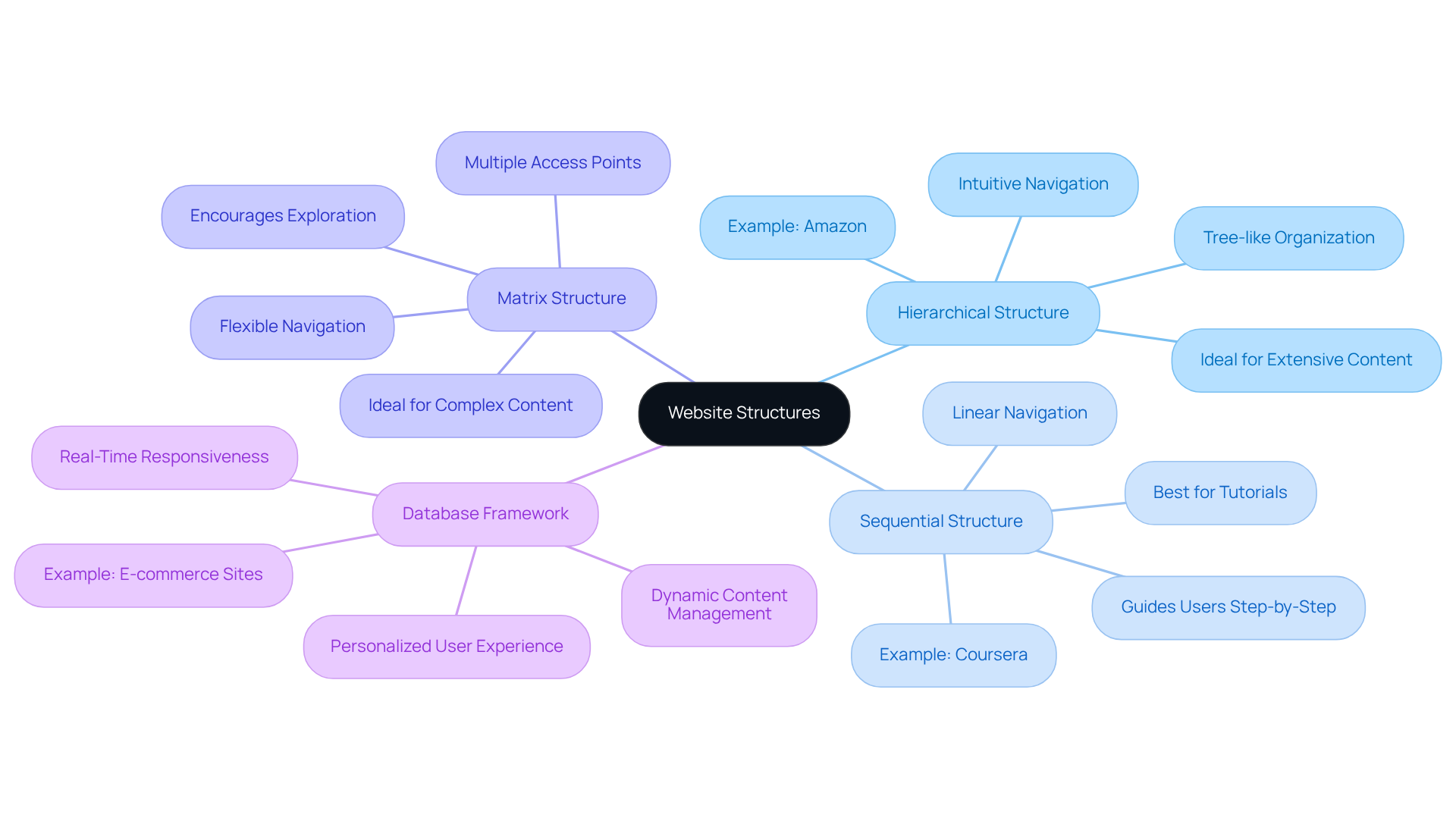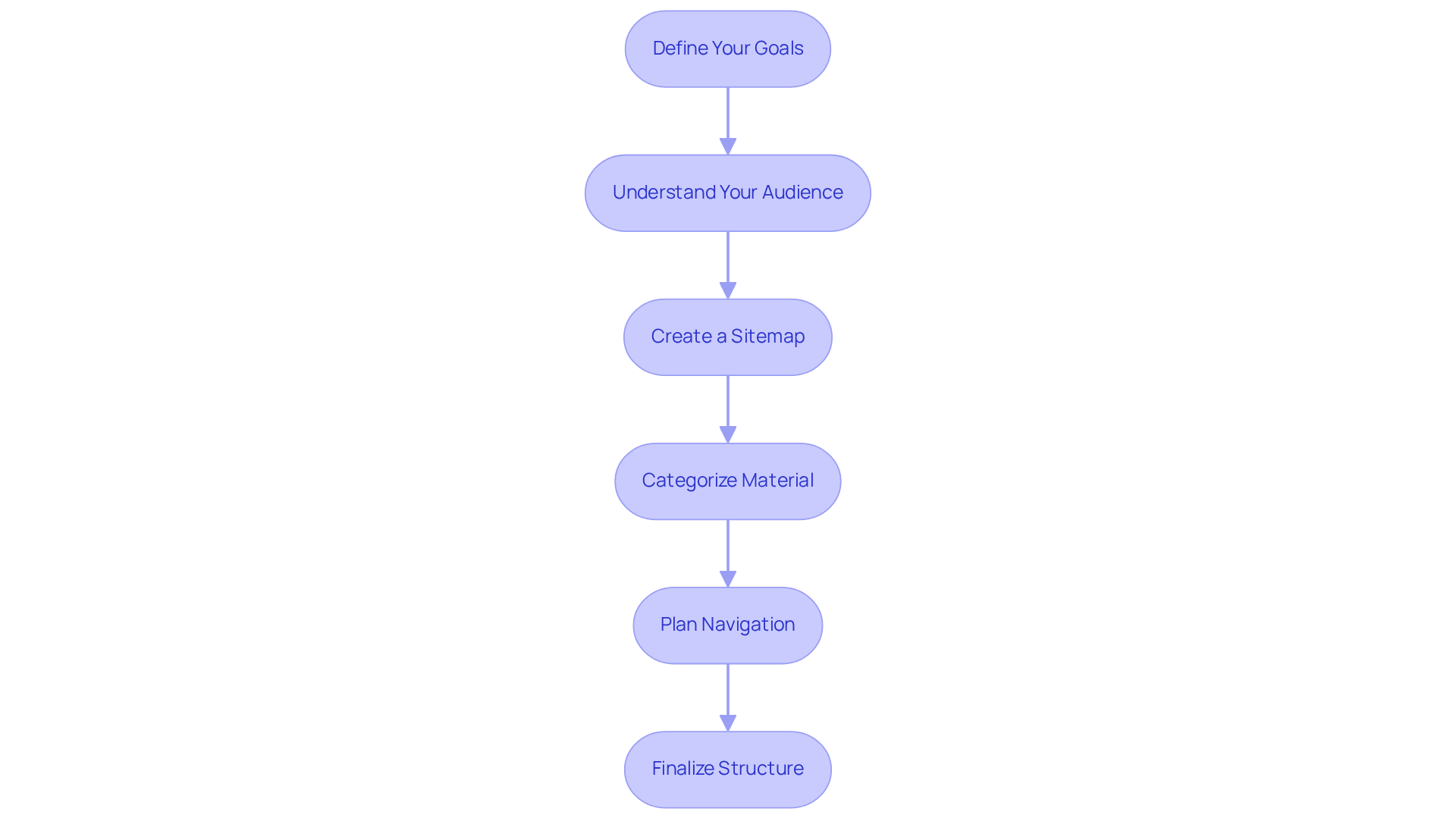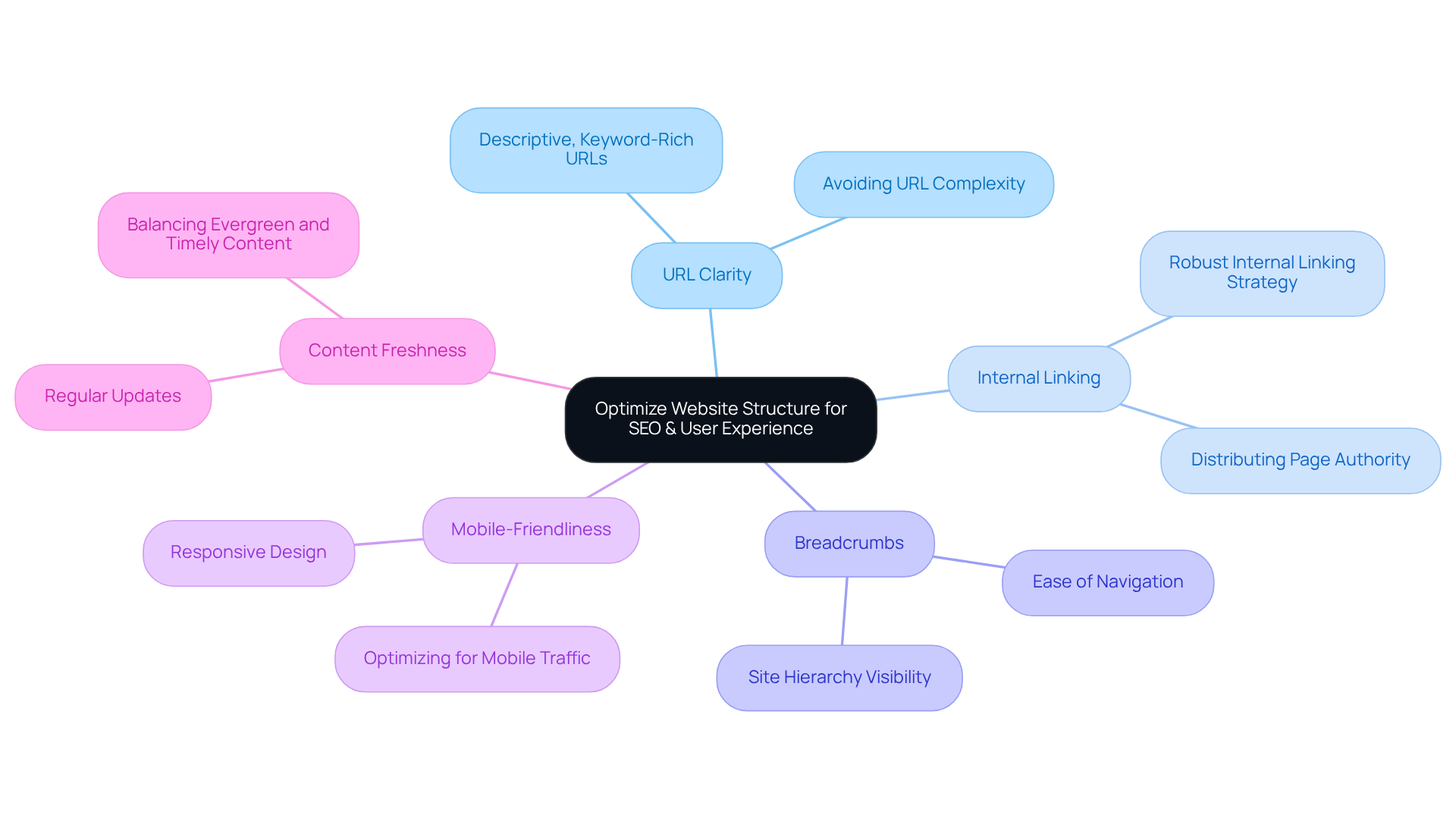Overview
In the journey of building a successful online presence, many tech startup founders face a common challenge: the struggle to create a website that truly resonates with their audience. This challenge can lead to frustration, as unclear structures often result in poor user experiences and diminished visibility in search engine results. The implications of this are significant, affecting not only user engagement but also conversion rates, which are crucial for growth.
However, there is hope. By optimizing your website structure, you can foster a more intuitive and effective experience for your users. Start by defining your goals; what do you want your website to achieve? Understanding your audience is equally vital—who are they, and what do they seek? From there, creating a sitemap can serve as a roadmap, guiding both you and your visitors through the content you offer. Lastly, planning your navigation thoughtfully can make all the difference in how users interact with your site.
Together, these steps can transform your website into a space that not only attracts visitors but also keeps them engaged. By embracing clarity and organization, you pave the way for increased engagement and conversion rates, ultimately leading to the success you envision for your startup. Remember, you are not alone in this journey; many have walked this path and found solutions that work. Let's take these steps together, fostering a community of support and shared experiences.
Introduction
A well-organized website structure is truly the backbone of a successful online presence, affecting everything from user experience to search engine visibility. Many website owners find themselves grappling with the challenge of creating an intuitive framework that not only captivates visitors but also enhances SEO. This balancing act can often feel overwhelming, as the aesthetic appeal of a site may clash with the need for functional organization.
Have you ever felt this struggle? You’re not alone. Crafting a site that guides visitors effortlessly through content while paving the way for increased organic traffic and engagement is essential.
This article explores practical steps for refining your website architecture, offering a supportive path to unlock greater success in the digital landscape. Together, we can navigate this journey toward a more effective online presence.
Define Website Structure and Its Importance
The website site structure is more than just a technical detail; it’s about how we organize and present information on our websites. It’s crucial for fostering a positive user experience and ensuring that visitors can find what they need without frustration. Think about it: when a website is easy to navigate, users tend to stay longer and explore more. This not only enhances their experience but also significantly reduces bounce rates. After all, who doesn’t appreciate a smooth, hassle-free journey through a site?
Moreover, the website site structure plays a vital role in improving search engine optimization (SEO). Search engines thrive on clarity, and a clear site framework allows them to crawl and index pages effectively. When your website site structure is organized thoughtfully, it becomes more . Research has shown that businesses with optimized designs can experience a remarkable increase in organic traffic—some reports even suggest up to a 50% boost after implementing design enhancements. This is not just a statistic; it’s a transformative opportunity for your startup.
Managing information becomes a breeze with a clear website site structure implemented. It simplifies the process of updating content and integrating new offerings, which is especially important for startups that frequently introduce new products or services. Imagine the ease of adding fresh content without disrupting the user experience—this is the kind of efficiency that can set your startup apart.
In essence, a well-structured website site structure is not merely about aesthetics; it’s a cornerstone of achieving your business goals. It enhances user satisfaction and optimizes search engine performance, leading to improved engagement metrics and higher conversion rates. As Neil Patel wisely states, 'No online presence can stand without a strong backbone.' And that backbone is technical SEO, which underscores the importance of thoughtful website organization. So, let’s embrace this journey together, ensuring that your website not only looks good but also works hard for you and your users.

Explore Different Types of Website Structures
Understanding is essential for enhancing user experience and navigation, and it can truly make a difference. Many of us have faced the frustration of navigating a poorly organized website, which can lead to lost opportunities and diminished engagement. Let's explore some common types of website site structures that can help alleviate these issues and create a more positive experience for users.
- Hierarchical Structure: This format is the most common, organizing information in a tree-like manner. It begins with a homepage that branches out into categories and subcategories, making navigation intuitive. Research indicates that 94% of initial impressions are design-related, underscoring the importance of a well-organized site in shaping perceptions. Imagine the relief of your users as they easily find what they need, fostering a sense of trust and satisfaction.
- Sequential Structure: Often used by sites guiding individuals through a specific process, such as e-learning platforms, this structure presents information in a linear fashion. Each page naturally leads to the next, ensuring users follow a clear path. This approach shines in tutorials, where information needs to be processed in a specific order. Consider this: individuals spend an average of 5.59 seconds on a page engaging with written material. This highlights the necessity for a clear and captivating presentation in sequential formats, offering users a seamless experience.
- Matrix Structure: This design allows individuals to choose their navigation route, providing various options for exploring content. It’s especially beneficial for complex sites with diverse subjects, as it enhances engagement by granting users control over their browsing experience. The matrix design's non-linear navigation invites users to discover materials freely, catering to their unique interests and preferences.
- Database Framework: Ideal for data-heavy websites like eCommerce platforms, this framework dynamically generates content based on user interactions and inquiries. It enables real-time responsiveness and personalization, significantly enhancing user satisfaction. With 50% of U.S. e-commerce transactions occurring on mobile devices, a database-driven framework can elevate the mobile shopping experience by delivering customized information tailored to users' needs.
Choosing the right framework is crucial and should align with your website site structure, goals, target audience, and content type. For instance, brands like Amazon utilize a hierarchical framework to facilitate easy navigation through extensive product categories, while platforms like Coursera adopt a sequential format to effectively guide learners through courses. By understanding these frameworks, you can make informed design choices that lead to improved user experiences, fostering a supportive environment for your audience. Remember, the right structure not only enhances navigation but also nurtures a connection with your users, paving the way for meaningful interactions.

Plan and Organize Your Website Structure
To effectively plan and organize your website site structure, it’s important to address a common challenge many face: creating an online presence that truly resonates with your audience. This can feel overwhelming, but with a little guidance, you can navigate this journey successfully.
- Define Your Goals: Start by clearly identifying what you hope to achieve with your online platform. Are you looking to increase sales, generate leads, or provide valuable information to your audience? Understanding your goals is the first step towards a successful website.
- Understand Your Audience: Take the time to conduct thorough research on your target audience. Grasping their needs and preferences is essential for categorizing and presenting material effectively. Remember, statistics show that 85% of visitors form their opinions about a brand based on their initial online experience. This highlights the importance of aligning your content with audience expectations.
- Create a Sitemap: Visualize your website site structure by developing a . Tools like Lucidchart or Figma can help you draft a clear outline of the hierarchy of pages, ensuring a logical flow of information that feels intuitive to your visitors.
- Categorize Material: Group similar material together to enhance organization and improve SEO. Effective categorization creates topical relevance, which is vital for search engine visibility. Research indicates that companies investing heavily in UX design see a 75% increase in sales, underscoring the impact of well-organized content.
- Plan Navigation: Consider creating an intuitive navigation system that allows individuals to effortlessly locate what they seek. Implementing dropdown menus or breadcrumbs can enhance accessibility and overall experience. An astonishing 90% of individuals will continue purchasing on a platform that provides a positive experience, making navigation a crucial element of your site design.
As Audrey Rawnie wisely states, "Today more than ever, possessing a functional, well-designed online presence for your business is essential for your success." Additionally, with the typical e-commerce conversion rate on mobile being 2.49% and desktop conversions at 5.06%, it’s clear that enhancing your site for mobile visitors is crucial.
By following these steps, you can create a logical and user-friendly website site structure that aligns with your business objectives and resonates with your audience. Remember, you’re not alone in this journey; many have walked this path and found success, and so can you.

Optimize Your Website Structure for SEO and User Experience
To enhance your website site structure for both SEO and user experience, it’s essential to address some common challenges that many face. A significant issue is the lack of clarity in URLs, which can hinder both search engines and visitors. Crafting descriptive, keyword-rich URLs not only aids search engines in understanding your content but also provides visitors with valuable context. It’s concerning to know that 90.63% of pages receive no organic search traffic, underscoring the importance of effective URL structures. As Pratik Dholakiya wisely points out, 'SEO plays a huge role in B2B marketing as it can help achieve several goals, such as lead generation and brand awareness.'
Another challenge is navigation, which can often feel overwhelming. By implementing a robust internal linking strategy, you can connect related pages, enhancing navigation and improving the website site structure while distributing page authority throughout your site. This is crucial for improving overall SEO performance. Effective eCommerce sites, such as those highlighted in case studies from RNO1, frequently employ internal links to guide visitors through their product offerings, ultimately boosting engagement and conversion rates.
Additionally, many users struggle with navigation issues, which can be alleviated by incorporating breadcrumbs. This feature allows individuals to see their current position within the site hierarchy, making it easier for them to backtrack and explore related content. A well-organized breadcrumb trail can significantly enhance the visitor experience and reduce bounce rates.
In today’s mobile-centric world, ensuring your website site structure is responsive and mobile-friendly is more important than ever. With 63.31% of web traffic coming from mobile devices, a smooth is essential for retaining visitors and improving search rankings. As the industry emphasizes, 'Businesses must prioritize mobile-friendly websites to enhance user experience and capture the increasing mobile audience.'
Finally, keeping your material fresh and relevant is vital. Regular updates signal to search engines that your site is active, which can improve rankings. It’s worth noting that 47.6% of SEO professionals expressed dissatisfaction with their results in 2022, highlighting the necessity of ongoing content optimization.
By embracing these optimization techniques, you can significantly improve both user experience and your site's visibility in search engine results. Remember, you’re not alone in this journey; many share similar challenges, and together, we can work towards effective solutions.

Conclusion
A well-optimized website structure is essential for achieving online success. It serves as the backbone that supports not only user experience but also search engine visibility. When information is thoughtfully organized, businesses create an inviting atmosphere that draws visitors in and encourages them to explore further. This ultimately leads to higher conversion rates, a vital aspect of standing out in today’s competitive digital landscape.
Many founders face the challenge of unclear website structures, which can frustrate users and hinder search engine performance. This article delves into key aspects such as:
- Defining website structure
- Exploring various types
- Implementing effective planning and optimization strategies
It emphasizes the importance of a clear hierarchy, intuitive navigation, and mobile-friendliness, all of which enhance user satisfaction. Additionally, a well-structured site can significantly boost SEO performance, making it easier for search engines to index content and improve search rankings.
Investing time and effort into optimizing your website structure is more than just a matter of aesthetics; it’s about creating a seamless user journey that fosters trust and satisfaction. By following the outlined steps and best practices, you can ensure your website is not only functional but also capable of driving meaningful interactions. Embrace the journey of website optimization today, and witness the transformative impact it can have on your online presence and overall success. Remember, you’re not alone in this process; we’re here to support you every step of the way.
Frequently Asked Questions
What is website structure?
Website structure refers to the way information is organized and presented on a website, impacting navigation and user experience.
Why is website structure important for user experience?
A well-organized website structure enhances navigation, allowing users to find what they need easily, which encourages them to stay longer and explore more.
How does website structure affect bounce rates?
An easy-to-navigate website reduces frustration for users, leading to lower bounce rates as visitors are more likely to stay and engage with the content.
What role does website structure play in search engine optimization (SEO)?
A clear website structure allows search engines to crawl and index pages effectively, improving the site's visibility in search results and potentially increasing organic traffic.
How much can optimized website design impact traffic?
Research indicates that businesses with optimized website designs can experience an increase in organic traffic of up to 50% after implementing design enhancements.
How does a clear website structure assist startups?
It simplifies content management, making it easier for startups to update information and integrate new products or services without disrupting the user experience.
What are the overall benefits of a well-structured website?
A well-structured website enhances user satisfaction, optimizes search engine performance, improves engagement metrics, and increases conversion rates.
What is the relationship between website structure and technical SEO?
A strong website structure is considered the backbone of technical SEO, highlighting the importance of thoughtful organization for achieving business goals.




